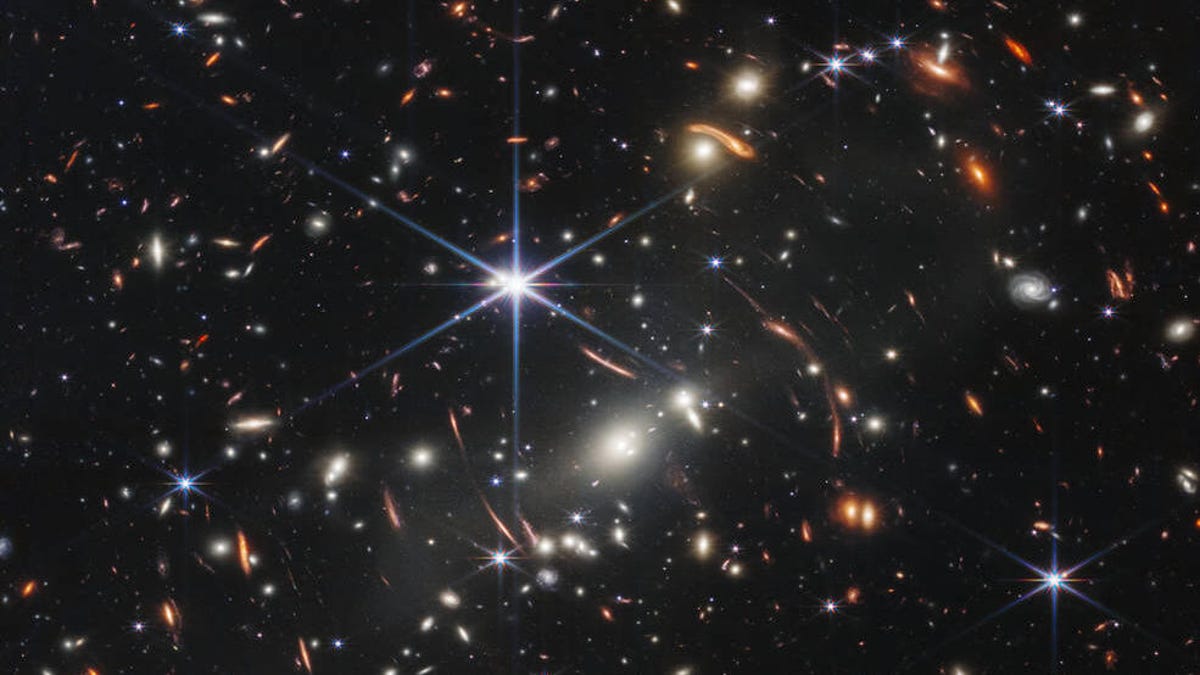NASA's Webb Space Telescope Drops Its First Warped Look Through Space and Time
This is the most detailed look we have ever had of our cosmos. It's remarkable.

This is the highest-resolution infrared view of the universe we've ever had.
Less than a century ago, we — humans — believed the universe ended at the very edge of the Milky Way. At the point where the last starlight of our home galaxy winked out, an endless nothing began.
Until Edwin Hubble. The famed astronomer diligently scoured the sky for blinking stars from Mount Wilson Observatory in California. His work with the Hooker telescope practically doubled the size of the universe in 1923, when he and others helped reveal that Andromeda was not a tightly packed bundle of stars within the Milky Way, but its very own galaxy, 2.5 million light-years away. Hubble knew how powerful technological advances were: Bigger, better telescopes would help expand our horizons ever further.
Eighty years later, Hubble's namesake space telescope would alter our view of the cosmic horizon once again with the release of the Hubble Ultra Deep Field image, a photograph of the universe that extends so far back in space and time that it revealed galaxies birthed just 600 million years after the Big Bang.
Today, as of July 11, 2022, our horizon expands once more. One hundred years of progress – in telescopy, astronomy, astrophysics, engineering, rocket science, mathematics, hell, even streaming online video – has led to NASA unveiling the first image obtained by the James Webb Space Telescope.
After a protracted wait that led to a heated discussion of NASA TV's "hold music" online, it was President Joe Biden who had the honor of releasing Webb's first look across the universe, an image dubbed "Webb's First Deep Field" on Monday. The press conference lasted for just 10 minutes and was a huge missed opportunity, but it delivered a historic first image from across the cosmos.
"If you held a grain of sand on the tip of your finger at arm's length, that is the part of the universe that you're seeing — just one little speck," said NASA Administrator Bill Nelson during the press conference.
The full image is below.
The whole shebang of the highest-resolution image of the infrared universe yet.
The Deep Field examines a corner of space known as SMACS 0723, which has been eyed by space telescopes such as Hubble. It contains a mammoth cluster of galaxies that function as a lens, magnifying the light of galaxies from much farther into the cosmos.
One of the most notable aspects of this Webb image — and the images to come — is the six-pointed light you can see in the image, a function of how the mirrors in the James Webb telescope are shaped.
There's also a circular smudging of light throughout the center of the image. This is the "lensing" effect. The gravity of huge foreground clusters, which are only about 4 billion light-years away, alter the way light from deep, deep space reaches the telescope. In some cases, galaxies appear in two spots because of the effect, and astronomers can study this light to better understand what those deep galaxies look like.
When you compare it to the Hubble image of the same region, the difference is mind-boggling.
I had to make a before and after to really appreciate how good the James Webb Telescope really is. pic.twitter.com/dj0HL8XGaZ
— Jason Short (@jason4short) July 11, 2022
The image itself is not exactly "hot off the telescope." This isn't what Webb sees. Webb's imaging capabilities capture infrared light from cosmic objects in black and white, similar to Hubble, and image-processing software is used to reveal all the subtleties of space. Those who helped create the images then perform a feat of technical and artistic wizardry: They map the infrared wavelengths to colors to highlight the most significant features in an image.
Some of the galaxies in the image existed only a few hundred million years after the Big Bang. Because of Webb's powerful optics, we're seeing them for the first time ever. What's really interesting about them is that they appear bigger than galaxies which are technically much closer.
"The redder galaxies in the image are much farther from us than the bluer ones - so you would expect them to look smaller than the blue ones," says Jonti Horner, an astrophysicist at the University of Southern Queensland in Australia. Instead, he notes, the redder galaxies look much bigger because of a quirk of light known as "angular diameter turnaround." It will make your head hurt, but when those old galaxies first emitted light, the universe was much more compact, meaning they were much more close by at the time. Gah!
While the Deep Field delights, it's merely the entrée. Tomorrow, NASA will provide a buffet of Webb images to feast on in a breakthrough look across deep space. The release will highlight dazzling nebulas, illuminate alien worlds and pull back the curtain on a group of colliding galaxies. If this first image is anything to go by, you'll want to gorge yourself on those, too. We've got you covered: Here's when and where to catch the drop, but you can also watch the CNET Highlights livestream, which I've embedded below.
Update, 6 p.m. PT: Added comments from scientists.

